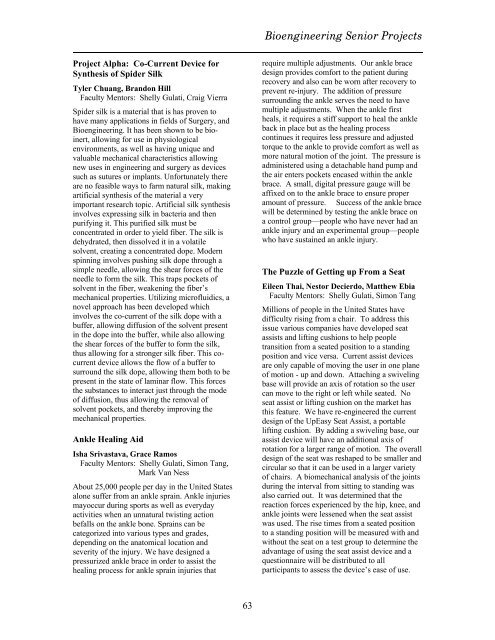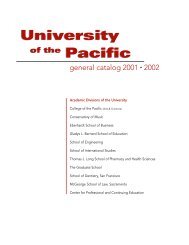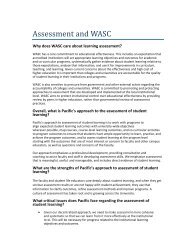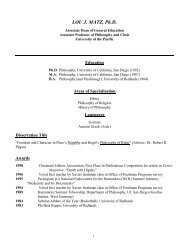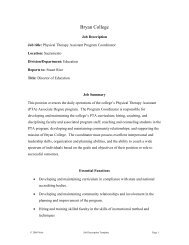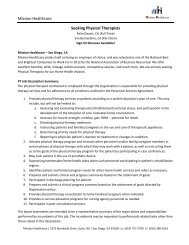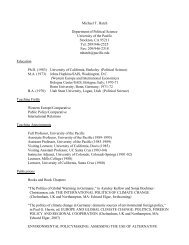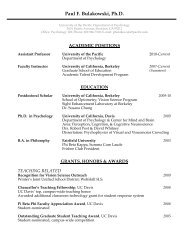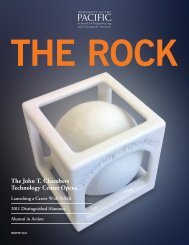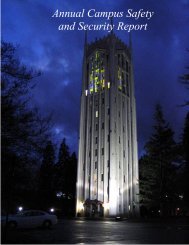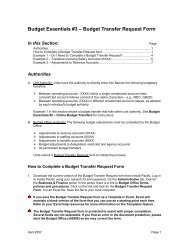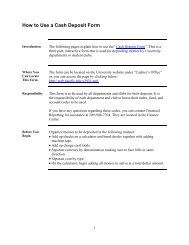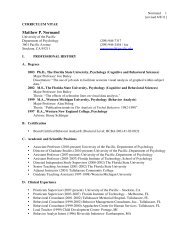purcc 2012 - University of the Pacific
purcc 2012 - University of the Pacific
purcc 2012 - University of the Pacific
Create successful ePaper yourself
Turn your PDF publications into a flip-book with our unique Google optimized e-Paper software.
Bioengineering Senior Projects<br />
Project Alpha: Co-Current Device for<br />
Syn<strong>the</strong>sis <strong>of</strong> Spider Silk<br />
Tyler Chuang, Brandon Hill<br />
Faculty Mentors: Shelly Gulati, Craig Vierra<br />
Spider silk is a material that is has proven to<br />
have many applications in fields <strong>of</strong> Surgery, and<br />
Bioengineering. It has been shown to be bioinert,<br />
allowing for use in physiological<br />
environments, as well as having unique and<br />
valuable mechanical characteristics allowing<br />
new uses in engineering and surgery as devices<br />
such as sutures or implants. Unfortunately <strong>the</strong>re<br />
are no feasible ways to farm natural silk, making<br />
artificial syn<strong>the</strong>sis <strong>of</strong> <strong>the</strong> material a very<br />
important research topic. Artificial silk syn<strong>the</strong>sis<br />
involves expressing silk in bacteria and <strong>the</strong>n<br />
purifying it. This purified silk must be<br />
concentrated in order to yield fiber. The silk is<br />
dehydrated, <strong>the</strong>n dissolved it in a volatile<br />
solvent, creating a concentrated dope. Modern<br />
spinning involves pushing silk dope through a<br />
simple needle, allowing <strong>the</strong> shear forces <strong>of</strong> <strong>the</strong><br />
needle to form <strong>the</strong> silk. This traps pockets <strong>of</strong><br />
solvent in <strong>the</strong> fiber, weakening <strong>the</strong> fiber’s<br />
mechanical properties. Utilizing micr<strong>of</strong>luidics, a<br />
novel approach has been developed which<br />
involves <strong>the</strong> co-current <strong>of</strong> <strong>the</strong> silk dope with a<br />
buffer, allowing diffusion <strong>of</strong> <strong>the</strong> solvent present<br />
in <strong>the</strong> dope into <strong>the</strong> buffer, while also allowing<br />
<strong>the</strong> shear forces <strong>of</strong> <strong>the</strong> buffer to form <strong>the</strong> silk,<br />
thus allowing for a stronger silk fiber. This cocurrent<br />
device allows <strong>the</strong> flow <strong>of</strong> a buffer to<br />
surround <strong>the</strong> silk dope, allowing <strong>the</strong>m both to be<br />
present in <strong>the</strong> state <strong>of</strong> laminar flow. This forces<br />
<strong>the</strong> substances to interact just through <strong>the</strong> mode<br />
<strong>of</strong> diffusion, thus allowing <strong>the</strong> removal <strong>of</strong><br />
solvent pockets, and <strong>the</strong>reby improving <strong>the</strong><br />
mechanical properties.<br />
Ankle Healing Aid<br />
Isha Srivastava, Grace Ramos<br />
Faculty Mentors: Shelly Gulati, Simon Tang,<br />
Mark Van Ness<br />
About 25,000 people per day in <strong>the</strong> United States<br />
alone suffer from an ankle sprain. Ankle injuries<br />
mayoccur during sports as well as everyday<br />
activities when an unnatural twisting action<br />
befalls on <strong>the</strong> ankle bone. Sprains can be<br />
categorized into various types and grades,<br />
depending on <strong>the</strong> anatomical location and<br />
severity <strong>of</strong> <strong>the</strong> injury. We have designed a<br />
pressurized ankle brace in order to assist <strong>the</strong><br />
healing process for ankle sprain injuries that<br />
require multiple adjustments. Our ankle brace<br />
design provides comfort to <strong>the</strong> patient during<br />
recovery and also can be worn after recovery to<br />
prevent re-injury. The addition <strong>of</strong> pressure<br />
surrounding <strong>the</strong> ankle serves <strong>the</strong> need to have<br />
multiple adjustments. When <strong>the</strong> ankle first<br />
heals, it requires a stiff support to heal <strong>the</strong> ankle<br />
back in place but as <strong>the</strong> healing process<br />
continues it requires less pressure and adjusted<br />
torque to <strong>the</strong> ankle to provide comfort as well as<br />
more natural motion <strong>of</strong> <strong>the</strong> joint. The pressure is<br />
administered using a detachable hand pump and<br />
<strong>the</strong> air enters pockets encased within <strong>the</strong> ankle<br />
brace. A small, digital pressure gauge will be<br />
affixed on to <strong>the</strong> ankle brace to ensure proper<br />
amount <strong>of</strong> pressure. Success <strong>of</strong> <strong>the</strong> ankle brace<br />
will be determined by testing <strong>the</strong> ankle brace on<br />
a control group—people who have never had an<br />
ankle injury and an experimental group—people<br />
who have sustained an ankle injury.<br />
The Puzzle <strong>of</strong> Getting up From a Seat<br />
Eileen Thai, Nestor Decierdo, Mat<strong>the</strong>w Ebia<br />
Faculty Mentors: Shelly Gulati, Simon Tang<br />
Millions <strong>of</strong> people in <strong>the</strong> United States have<br />
difficulty rising from a chair. To address this<br />
issue various companies have developed seat<br />
assists and lifting cushions to help people<br />
transition from a seated position to a standing<br />
position and vice versa. Current assist devices<br />
are only capable <strong>of</strong> moving <strong>the</strong> user in one plane<br />
<strong>of</strong> motion - up and down. Attaching a swiveling<br />
base will provide an axis <strong>of</strong> rotation so <strong>the</strong> user<br />
can move to <strong>the</strong> right or left while seated. No<br />
seat assist or lifting cushion on <strong>the</strong> market has<br />
this feature. We have re-engineered <strong>the</strong> current<br />
design <strong>of</strong> <strong>the</strong> UpEasy Seat Assist, a portable<br />
lifting cushion. By adding a swiveling base, our<br />
assist device will have an additional axis <strong>of</strong><br />
rotation for a larger range <strong>of</strong> motion. The overall<br />
design <strong>of</strong> <strong>the</strong> seat was reshaped to be smaller and<br />
circular so that it can be used in a larger variety<br />
<strong>of</strong> chairs. A biomechanical analysis <strong>of</strong> <strong>the</strong> joints<br />
during <strong>the</strong> interval from sitting to standing was<br />
also carried out. It was determined that <strong>the</strong><br />
reaction forces experienced by <strong>the</strong> hip, knee, and<br />
ankle joints were lessened when <strong>the</strong> seat assist<br />
was used. The rise times from a seated position<br />
to a standing position will be measured with and<br />
without <strong>the</strong> seat on a test group to determine <strong>the</strong><br />
advantage <strong>of</strong> using <strong>the</strong> seat assist device and a<br />
questionnaire will be distributed to all<br />
participants to assess <strong>the</strong> device’s ease <strong>of</strong> use.<br />
63


